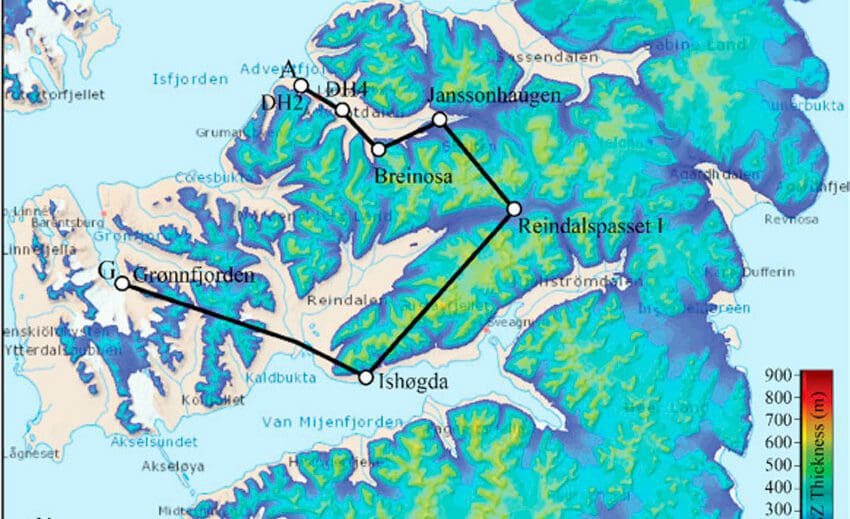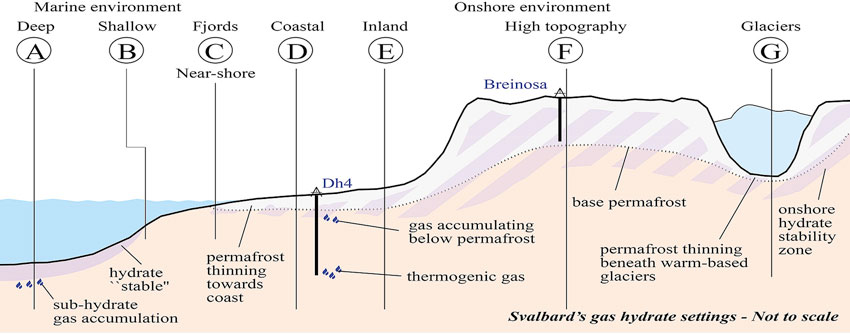Gas hydrates in Svalbard

The cold of Norway’s High Arctic may just be cold enough to push natural gas into a different phase; one where natural gas combines with a cage of water molecules to form a hydrate structure.
15 April 2019
Text: Peter Betlem, UNIS PhD candidate in carbon capture storage
The amount of natural gas potentially trapped in hydrate deposits is thought to be similar to that of all other hydrocarbons combined. With 160 times the gas density of natural gas, a small volume of gas hydrate holds immense potential, even at relatively shallow depths. Hydrates are considered a resource, a medium for carbon capture and storage, and even a climate risk due to their climate change potential.
But this comes with a catch: the hydrate structure is only stable under high pressures or at low temperatures. In practice this means that natural hydrates often occur in the deep oceans and or in association with permafrost.

Svalbard, situated halfway between northern Norway and the North Pole, features both. While its deep-water marine hydrate setting has been extensive studied and hydrates have even been observed, for example, at Vestnesa Ridge, its onshore parts have thus far remained overlooked with respect to hydrate exploration.
Here the hydrate stability zone (the zone where temperature and pressure are suitable for hydrate formation) is observed to be related to permafrost extent.
Although gas hydrates have yet to be seen directly, there is increasingly strong evidence for their occurrence onshore.
We have constructed geophysical models based on 26 scenarios with different parameters (such as subsurface pressure and geothermal conditions), as well as a base case scenario.
Even in the most unlikely scenarios, a gas hydrate stability zone (GHSZ) was observed, at least locally. This means the geophysical conditions are favorable.
The GHSZ highlights where temperature and pressure conditions are favourable to hydrate formation, but does not tell you exactly where hydrates are present in the subsurface. In addition to having suitable temperature and pressure conditions, hydrates require hydrocarbons to form.
Understanding petroleum flows and hydrocarbon migration is therefore important to pinpoint where the chemical conditions for hydrate formation are met.

While higher elevations all fall well within the hydrate stable zone according to the models, most other parts of Svalbard are at the edge of stability, and that could be a problem. As the permafrost thaws, so too does the hydrate that is associated with it, potentially releasing harmful greenhouse gases into the atmosphere.
Ongoing efforts target the base permafrost in Adventdalen, and the pingos in Nordenskiöldland. These are sites that feature above-average hydrocarbon concentrations and increased pressure regimes, turning them into prime candidates.
Further, the heavily fluid-seeping fjords around central Spitsbergen are also an interesting setting that may well be worth exploring. Like their onshore counterpart, they feature cold temperatures in addition to their deep depths.
Given that Svalbard is host to suitable temperature-pressure conditions and a proven petroleum system, we may only conclude that natural gas hydrates almost certainly exist somewhere onshore in Svalbard.
Reference: P. Betlem, K. Senger, A. Hodson: 3D thermobaric modelling of the gas hydrate stability zone onshore central Spitsbergen, Arctic Norway. Marine and Petroleum Geology, Volume 100, February 2019, Pages 246-262.
This article was first published on geoforskning.no.